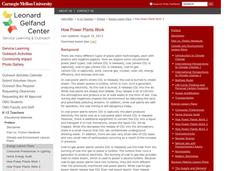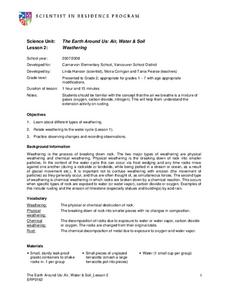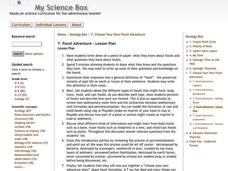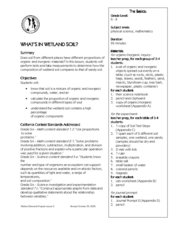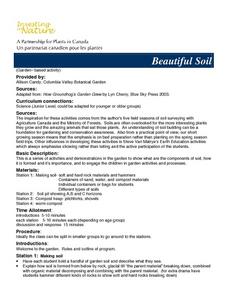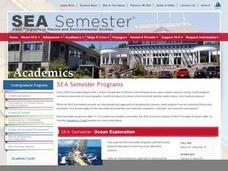Carnegie Mellon University
How Power Plants Work 2
In this second of three lessons on power plants, future engineers find out how we generate electricity and how coal-powered plants operate. They work in small groups to make electromagnet generators to light LED bulbs. A set of...
Carnegie Mellon University
How Power Plants Work 3
Double, double toil and trouble, fire burn and cauldron bubble! Find out what drives a turbine to generate electricity and whether or not it has an impact on the environment. A discussion and lecture is divided by a hands-on activity in...
Curated OER
Packing Nouns
Play a noun game with your class. Put a suitcase in the middle of the room and have each class member, in turn, name a noun that begins with a specified letter of the alphabet. To ramp up the challenge, assign concrete, abstract, proper,...
Curated OER
Rockin' Map Summaries
Learners summarize a piece of text. After reviewing the correct way to read and summarize, students work in groups to summarize a piece of text assigned by the instructor. They write a summary paragraph by creating a story map and the...
Curated OER
Where are the Watersheds in San Francisco?
Students create a mental map of San Francisco. They compare it with actual topographical maps of the city. Then they label various locations on the San Francisco Hillshade map and locate watershed boundaries.
Curated OER
Tables and Data
In this data analysis worksheet, 3rd graders answer eight short answer questions based on the information on the table. Students use the data from the table to answer the questions.
Curated OER
Weathering
Second graders explore weathering and how the water cycle plays a part in weathering. In this weathering lesson, 2nd graders put gravel and sugar cubes in a jar and shake, simulating weathering. Students use the scientific method to...
Curated OER
Exploring Meteorite Mysteries: Building Blocks of Planets
Students simulate the formation of chondrites and asteroids. In this astronomy lesson plan, students demonstrate accretion using balloons and static electricity. They compare and contrast their models to the actual process of chondrites...
Curated OER
Fossil Adventure
Students create a book about the process of a dinosaur becoming a fossil. In this earth science lesson, students are taught about fossils and create a book that tells what happened to a dinosaur's bones after they die.
Curated OER
Minerals and the Products of Mining
Students plot where minerals come from and have an awareness of how mineral use makes the world interdependent. They examine how to identify some sort of mineral products they use each day.
Curated OER
Weathering Walk
In this weathering activity, students walk around campus and observe ten examples of both mechanical and chemical weathering. They answer questions related to their observations.
Curated OER
Surface Water and Groundwater
Students examine distribution of water and minerals. In this surface and groundwater instructional activity, students conduct an experiment with fresh and salt water making hypothesis and drawing conclusions about minerals.
Curated OER
The World Of Earth Science
In this science activity, learners examine the topic in order to solidify knowledge covered in the curriculum using puzzles and creative games.
Curated OER
Characteristics of Africa
Students describe basic land features and characteristics that make up the continent of Africa, describe the people of Africa, where they live, and how they live and get a sense of what it is like to live in Africa.
Curated OER
Literacy Activity: The Perfect Pet
Students develop their listening skills as they listen to the book The Perfect Pet. In this reading lesson, students listen to the book, and then talk about the pets they have. Then they make a graph as a class of all their pets.
Curated OER
What's in Wetland Soil?
Students examine the organic and inorganic components of soil. In this environmental science lesson, students identify the factors that influence soil formation. They collect soil samples, conduct tests, and analyze the results.
Curated OER
Compositional Techniques: Are There Similarities Between
High schoolers recognize how chromatic scales create tension and pentatonic scales create relaxation as compositional techniques used to create tonality. Also, students aurally recognize the use of mixed or alternating meter as a means...
Curated OER
What Makes Up Your Profile?
Second graders understand what a profile is and relate to the profile of soil. In this soil profile activity students use cereal to simulate soil profile. Students draw and label their profiles using accurate soil vocabulary.
Curated OER
Web of Life - Role-Playing
Students role-play how organisms adapt to their environment. They play 20 questions with plant and animal habitats. They create a web of life to demonstrate how each plant and animal relies on the other for survival.
Curated OER
Beautiful Soil
Students discover what are the components of soil. They examine how it is formed and it's importance. They engage in garden activities and processes. They hold a handful of garden soil and describe what they see. They take a...
South Penquite Farms
Measuring Soil Temperatures
Using an auger, start-up soil scientists bore a core of soil. They examine the sample and record the temperature at three depths in the borehole. This is an attractive activity sheet that succinctly guides your earth science class...
Curated OER
Sampling the Ocean Floor
Students sample goodies from an unseen ocean floor and try to accurately describe their composition. This simulation helps students explain the limitations of sampling and the problem of obtaining representative samples of sea floor...
Discovery Education
Sonar & Echolocation
A well-designed, comprehensive, and attractive slide show supports direct instruction on how sonar and echolocation work. Contained within the slides are links to interactive websites and instructions for using apps on a mobile device to...
Curated OER
Plants and Ecosystems
The relationships within and between ecosystems can be explored. after examining an area for living and non-living things students complete the same examination in the forest ecosystem. Students identify abiotic and biotic elements in an...



